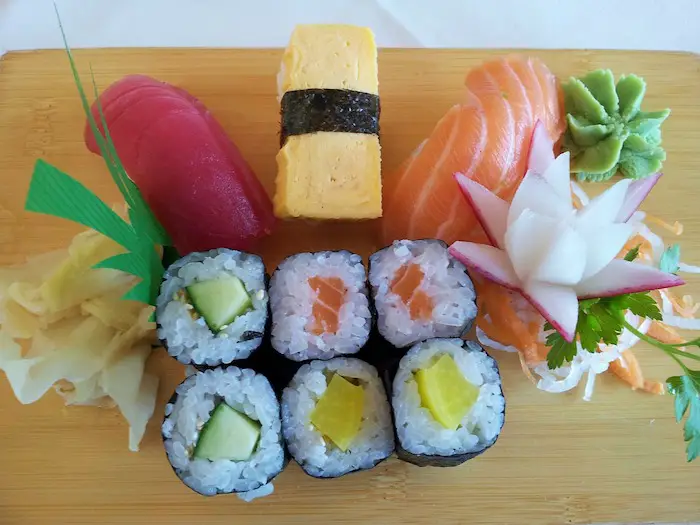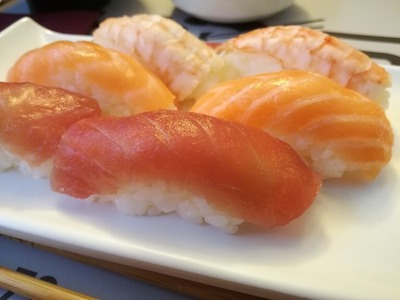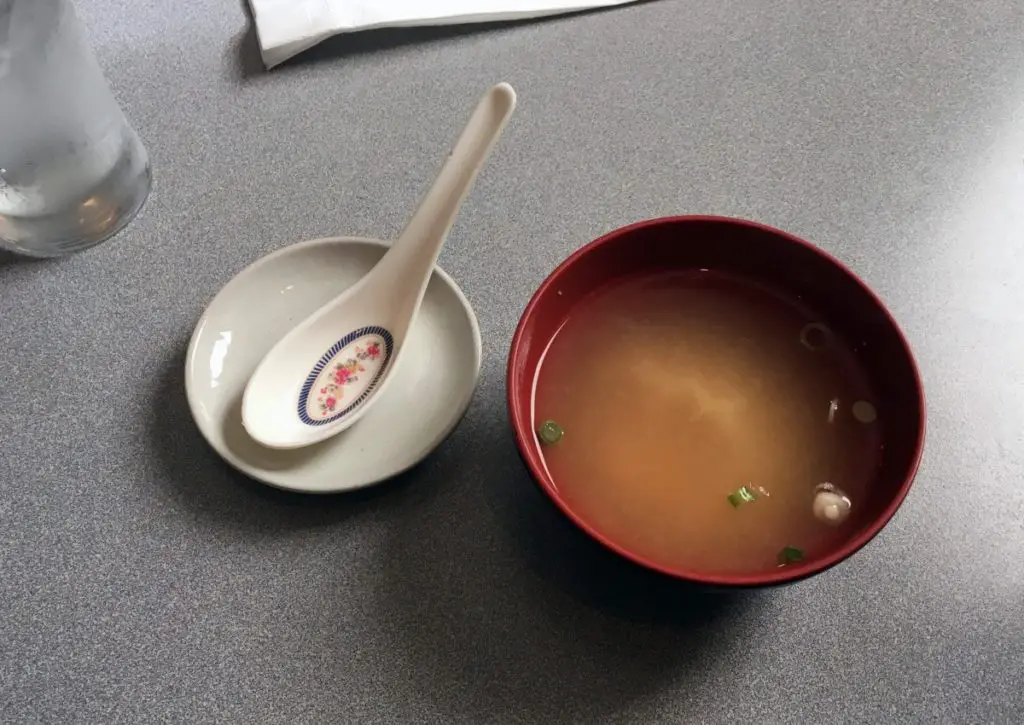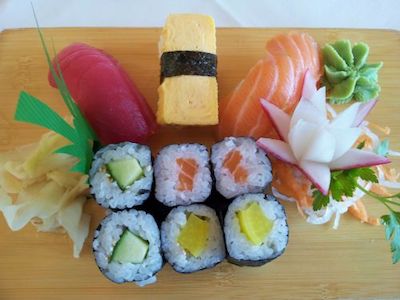We are reader supported. When you purchase through links on our site, we may earn an affiliate commission. Also, as an Amazon affiliate, we earn from qualifying purchases.

Sushi is widely touted by nutritionists as healthy food, so it may come as a surprise if I tell you that eating too much sushi can tip the weighing scale. If you are trying hard to lose a few inches from your waistline this may be heartbreaking news for you.
So, does sushi make you fat? That’s a tricky question that cannot be an absolute ‘No’ or ‘Yes’. It all depends on the type of sushi you eat. The traditional sushi is made of steamed rice, lean meat, and veggies that count less than 200 calories per roll. However, a shrimp tempura roll or Philadelphia roll can easily pack 500 calories or even more.
When it comes to being lean food, the new wave of sushi is far from it. They are packed with a lot of fat and high-calorie ingredients such as fried items, cream cheese, fatty meats, and thick sauces. For example, a shrimp tempura roll contains about 542 calories while a dragon roll can give you 520 calories – not a great number if you are trying to lose weight!
I often choose to go for the ‘in-between’ rolls that are not lean but also not too fatty. For example, a spider roll that can be around 350 calories and spicy tuna roll that may contain 300 calories. But then the calories don’t stop there. I usually find myself indulging in some extras like teriyaki skewers, dumplings, and green tea ice cream that can easily soar up the calorie meter.
Contents
Things In Sushi That Can Make You Fat
While sushi pieces may look harmless and too small to make a difference, there are several fat contributors if you look closer. Let’s discuss the things in sushi that can increase your weight.
1. Refined Carbs In Sushi
The most important element in sushi is short-grain Japanese rice, a type of white rice that is refined and stripped of all essential vitamins, minerals, and fiber. Studies have shown that a high intake of refined carbs can result in a spike of blood sugar levels.
Cooked sushi rice is often seasoned with vinegar, sugar, and salt. The low fiber content and added sugar mean that sushi’s carbs can be easily broken down in the digestive system, thus you feel hungry very quickly. A person who eats a lot of refined carbs can end up overeating, which results in an increase in fat content.
If you wish to watch your carbs intake, consider substituting white rice with brown rice as the later has more nutritional value and higher fiber content. The only problem is that sushi does not taste the same without the sticky white rice.
Another method to cut back on carbs is to request your chef to make sushi with less rice and more fillings to increase the nutritional value. Alternatively, you may consider cooking sushi at home to get the liberty to include less rice and more lean meat and veggies of your choice.
2. High-Fat Content In Sushi
Sushi was earlier considered as one of the most popular weight-loss-friendly meals. However, the sushi rolls you can find in restaurants today are highly influenced by western culture. The extra doses of high-fat sauces, dollops of cream cheese, and rich fried tempura batter can significantly increase your calories.

To avoid getting fat from eating sushi, make healthy choices by ordering nigiri sushi and rolls that are not slathered in sauces and creams. If unsure, ask the server about fillings used in a sushi roll before placing your order.
If you wish to cut back on fat from your diet, you may politely request your chef to avoid adding cream cheese, fried items or mayo-based sauces to your roll. Those who are on a strict diet can make their own sushi rolls at home to satisfy the cravings without getting fat.
3. Low Protein In Sushi
I know most people think sushi is raw fish but if you look closer there’s actually very less amount of fish or vegetables in it. Most sushi contains very less portion of fish, which doesn’t even make up for the two portions of fish per week, recommended by nutritionists.
The fish part in a California roll or tuna nigiri weighs only about 5 grams. So, you may need to eat around 28-30 pieces of sushi in a week to achieve the recommended 140 grams fish per week. Just think about the amount of white rice and sauces that will go with the fish.
The sushi bento boxes you get at the grocery stores and supermarkets like Marks & Spencer also do not contain much fish. You will need to eat at least four boxes of sushi and consume over 1000 calories to get the suggested fish portion in your diet.
This makes sushi a low-fiber and low-protein meal, which is not effective at filling you up. Hence, you feel hungry again after a few hours or end up eating too many sushi rolls to feel satiated. To overcome this feeling of hunger even after a sushi meal, I recommend ordering some side dishes such as edamame, sashimi, miso soup, or wakame salad.
4. Higher Percentage Of Salt
Sushi is incomplete without soy sauce and Japanese shoyu has a high percentage of salt. Besides salt in sauces, some salt also goes into sushi rice when it’s seasoned with vinegar. Fillings like smoked fish, marinated seafood, tempuras, and pickled veggies may also contain high amounts of salt.
The chef already puts some soy sauce to the sushi roll and it is also served as dipping so you get a double dose of shoyu that has a high salt content. This not only increases blood pressure but also puts you at the risk of overeating.
To reduce your sodium intake, tell your chef to go easy on the sauces or avoid dipping your sushi in shoyu altogether. You may also make healthier choices by avoiding sushi that contains smoked fish such as salmon or mackerel. Miso soup can make you feel satiated but it also contains salt.
Tips To Enjoy Sushi Without Getting Fat
If you are gaining weight due to sushi then it’s not because of the dish but the choices you make when eating sushi. Sushi lovers like me can never abstain from savoring a few nigiris and sushi rolls on weekdays and a sushi bowl on weekends. So, here are a few tips to let you enjoy as much sushi you want without getting fat.
#1. Order the healthiest rolls
I know tempuras and cream cheese strips are tempting, but resist those urges and order healthy sushi rolls when you are eating out. Sushi can be a low-fat meal with fillings like clams and fresh oysters if you make the right choices.
To maximize the health benefits of the dish, order sushi rolls that are low in calories and high in omega-3s and protein, for example, salmon and tuna rolls. A salmon roll contains only 40 calories while a tuna roll has about 42 calories. They are also rich in vitamin D, which has a key role to play in fat loss.
#2. Add wasabi to your sushi rolls
If you want to watch your intake of sushi, add an extra dose of wasabi to your nigiri and rolls. The sharp condiment is known to contain antioxidants like isothiocyanates. However, most restaurants in the US serve fake wasabi made from grated horseradish, starch, and food coloring. Just a little bit is enough to add extra heat to your rolls and the fiery taste may dissuade you from overeating sushi.
#3. Stay away from fancy rolls
There’s a guilty pleasure in eating sushi rolls with extra crunchiness but they may make you repent later when the calories mount up. Health nutritionists recommend diners to stay away from all sorts of crunchy rolls that contain tempuras and other deep-fried fillings.
Also, say ‘No’ to the fried rolls with a golden crust on the top. Remember that the fancier a sushi looks, the unhealthier it is so don’t get lured by the face value. To avoid tipping the weight scale, go for the simple and traditional maki rolls.
#4.Opt for raw or steamed fish
If you are comfortable eating raw fish, there’s nothing quite like it. Lean cuts of sushi-grade fish without any marinades, sauces, or seasonings are the best. It allows you to appreciate the delicate flavors of different types of fish without overpowering them with condiments. Those who don’t like the taste of raw fish can opt for the steamed or grilled options that have minimal use of oil.
#5. Eat temaki rolls instead

If you want to cut back on carbs, eat temaki roll instead. This style of hand rolls has less rice and more fillings so you can eat as many without worrying about consuming too many carbs. Some people even choose to make riceless temaki rolls with just the fillings inside. Alternatively, you may choose substitutes for sushi rice, such as quinoa, cauliflower rice, and brown rice.
#6. Choose veggie rolls
If you like eating sushi frequently, try incorporating more veggie rolls in your meal. So, if you order a spicy tuna roll, your second and third rolls can be cucumber maki and avocado roll. With the rising globalization of sushi, chefs are looking for ways to use different veggies in order to attract vegetarians and vegan eaters.
Vegetables and fruits like Japanese cucumber, sea vegetables, avocados, bell peppers, carrots, and mangos are not only rich in nutrients but also low in fat and calories.
#7. Use low-sodium soy sauce
To reduce your salt intake, I would suggest that you request your sushi chef to use low-sodium soy sauce for preparing your order. In most cases, they will agree because they stock gluten-free and low-sodium supplies for guests who are on a special diet. Alternatively, you may choose to make sushi at home so that you can use healthier options for cooking.
#8. Say ‘No’ to creamy mayo
You don’t get sushi slathered in mayo and other sauces in Japan. The different types of specialty rolls you see in the American restaurants are mostly due to the western influence. It’s almost like eating a cheeseburger or mayo filled sandwich. If you are serious about not letting your waistline expand, ask your server for sushi that does not contain mayo or cream cheese.
#9. Try eating with chopsticks
As a non-Japanese, it may be challenging for you to use chopsticks but it’s not rocket science. While it’s completely acceptable to eat with your hands or fork, I would suggest trying to use chopsticks to slow down eating. So, instead of swallowing the food fast with a spoon or fork, use chopsticks to pace your orders and feel full with less food.
#10. Start your sushi meal with miso soup

If you are so hungry that you can easily shovel 3-4 sushi rolls, I would suggest that you start your meal by ordering miso soup first. The hot broth can calm down your hungry without adding up too many calories. You can then go ahead and order sushi rolls and side dishes.
#11. Keep a watch on your portions
This is a continuation of the previous tip to prevent sushi from making you fat. To ensure that you stick to the recommended serving size of one roll or six pieces, order some side dishes like sashimi, salad, and soup to fill you up.
A Healthy Sushi Meal
Whether you are trying to lose inches around your waist or maintain your weight, here’s a healthy sushi meal you can choose when you dine out. Here’s a breakdown of dishes you can order and still stay below 500 calories.
- Salmon sushi roll (brown rice) – About 200 calories
- One bowl miso soup – 50 calories
- Seaweed salad – 60 calories (considerably less than a salad with dressing)
- Half cup edamame – 125 calories
- Green tea – 0 calories
Total: 435 calories
If you like to eat sushi often, consider making sushi at home. I would recommend that you invest in buying a few sushi equipment and supplies so that you can keep control over what goes into the meal. I have created articles for beginners to learn how to cook sushi rice, easy to cook sushi recipes, and filling ideas.
Related Questions
How much sushi can I eat without getting fat?
If you don’t want to get extra calories, stick to six pieces of nigiri or sushi rolls (for women) and nine pieces of nigiri or sushi rolls (for men). Supplement your order with edamame, miso soup, and salad. Eat slow and chew your food properly to appreciate the flavors.
Can I eat sushi if I am prone to high blood pressure or fluid retention?
Excessive fluid retention can make you appear fatter than you actually are. So, if you are prone to fluid retention or high blood pressure, avoid regular soy sauce. One tablespoon of shoyu has 900-1,225 mg of salt, which is nearly equal to an adult’s entire daily intake of sodium. Choose low sodium soy sauce that has nearly 600 mg per tbsp.
How many calories and fat do the specialty rolls contain?
The specialty rolls are typically the ones that have western influence and they are often dunked in a lot of sauces and cream. Shrimp tempura roll has about 544 calories and 13 grams of fat; soft shell crab roll has 317 calories and 12 grams of fat; while the California roll comprises of 266 calories and 9 grams of fat.
Is sushi gluten-free?
Sushi may appear to be the safest food when you are on a gluten-free diet. However, please be warned that sushi is not free of wheat because there are several other ingredients other than rice, fish, and vegetables. The sauces and seasonings add to sushi, so be careful about your choices and opt for gluten-free tamari and avoid tempuras that may contain wheat.
References:
https://www.marieclaire.com/health-fitness/news/a750/suchi-diet-fat

